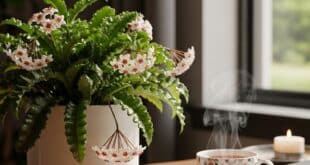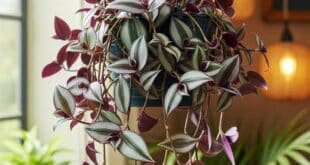Meet The Hoya Bella Plant
While most Hoyas are known for their tough, waxy leaves and drought-tolerant nature, the Hoya Bella gracefully breaks the mold. Often called the “Miniature Wax Plant,” this species is a delicate, charming outlier in the Hoya family, and understanding its unique needs is the key to success.
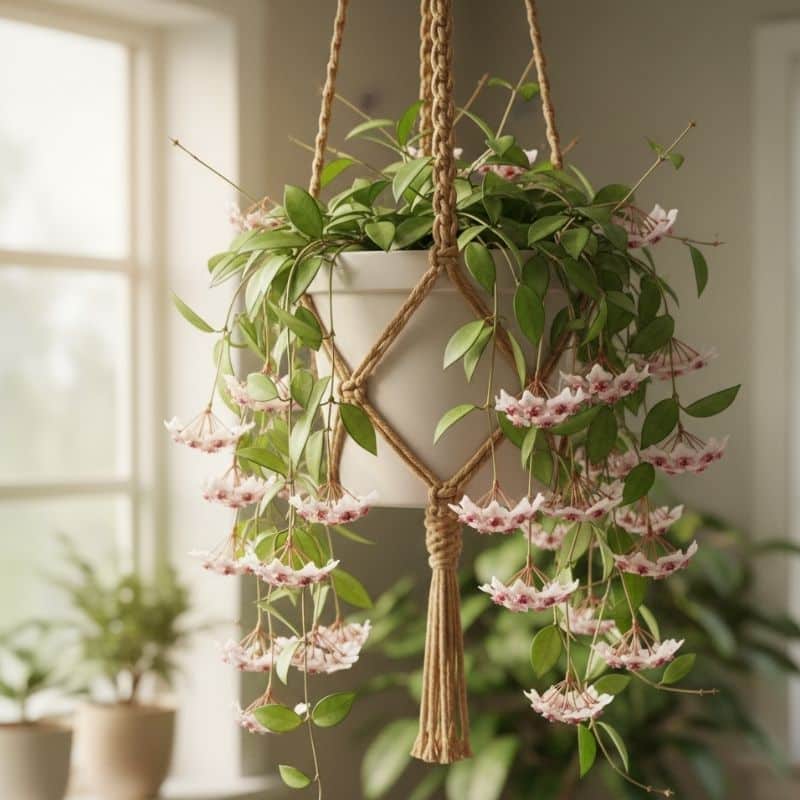
Known scientifically as Hoya lanceolata ssp. bella, this plant is adored for its small, pointed leaves and dainty, trailing vines that create a stunning cascade from a hanging basket. It’s a prolific bloomer, often gracing its owner with fragrant, star-shaped flowers.
But be warned: if you treat your Hoya Bella like a classic Hoya carnosa, you’ll run into trouble. This guide will cover the crucial differences and provide everything you need to know to let this delicate beauty thrive.
What Makes the Hoya Bella So Different?
The Hoya Bella stands apart from its more robust cousins in several important ways.
- Delicate, Non-Succulent Leaves: This is the most critical difference. Its leaves are small, diamond or lance-shaped, and relatively thin. Unlike the thick, water-storing leaves of a Hoya carnosa, Hoya Bella’s leaves are not very succulent. This directly impacts its watering needs.
- A True Trailing Habit: This plant has no desire to climb. Its thin, flexible stems will always grow downwards, making it a perfect “spiller” plant for hanging baskets and tall shelves.
- Thirstier Than Other Hoyas: Forget the “let it dry out completely” rule. Because its leaves don’t store much water, the Hoya Bella prefers its soil to remain consistently lightly moist. This is the golden rule of Hoya Bella care.
- Dainty, Perfumed Flowers: The flowers are classic Hoya—purple-centered white stars that look like delicate porcelain. They have a sweet fragrance and appear frequently along the stems, dangling like tiny jewels.
Hoya Bella vs. Classic Hoyas: A Critical Comparison
Let’s be clear about how its needs differ from a plant like Hoya carnosa.
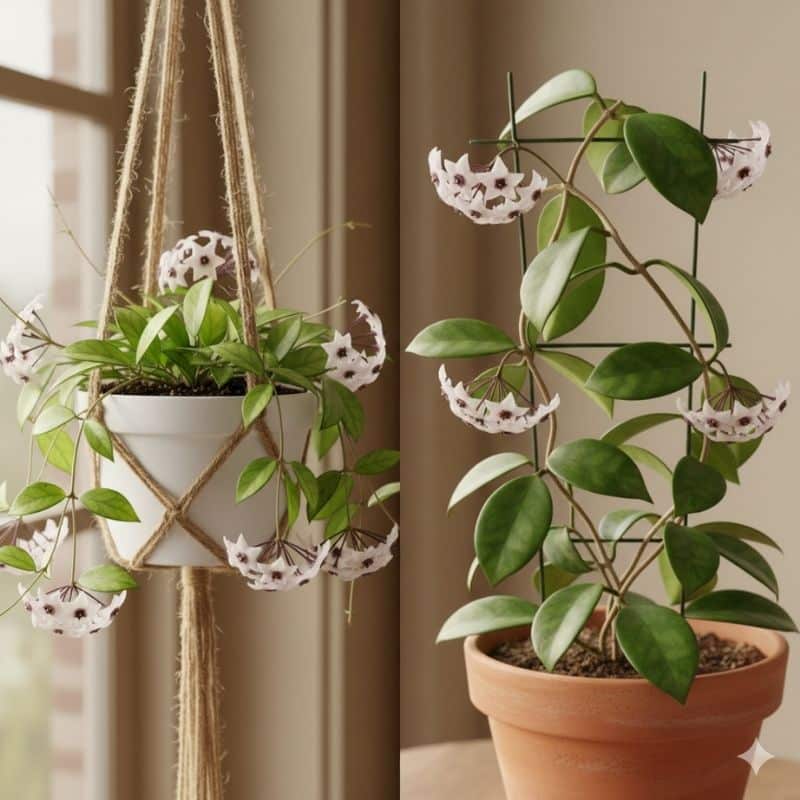
| Feature | Hoya Bella (H. lanceolata ssp. bella) | Classic Hoya Carnosa |
| Watering Needs | Prefers consistently moist soil; dislikes drying out completely. | Must dry out between waterings; prone to root rot if kept moist. |
| Leaf Type | Small, thin, pointed, non-succulent. | Large, thick, waxy, succulent (water-storing). |
| Growth Habit | Purely trailing with delicate, flexible stems. | Robust vining or climbing with woody stems. |
| Drought Tolerance | Low. Will decline quickly if left dry for too long. | High. Very forgiving of infrequent watering. |
Hoya Bella Care: A Recipe for Success
To keep this delicate Hoya happy, you need to adjust your mindset.
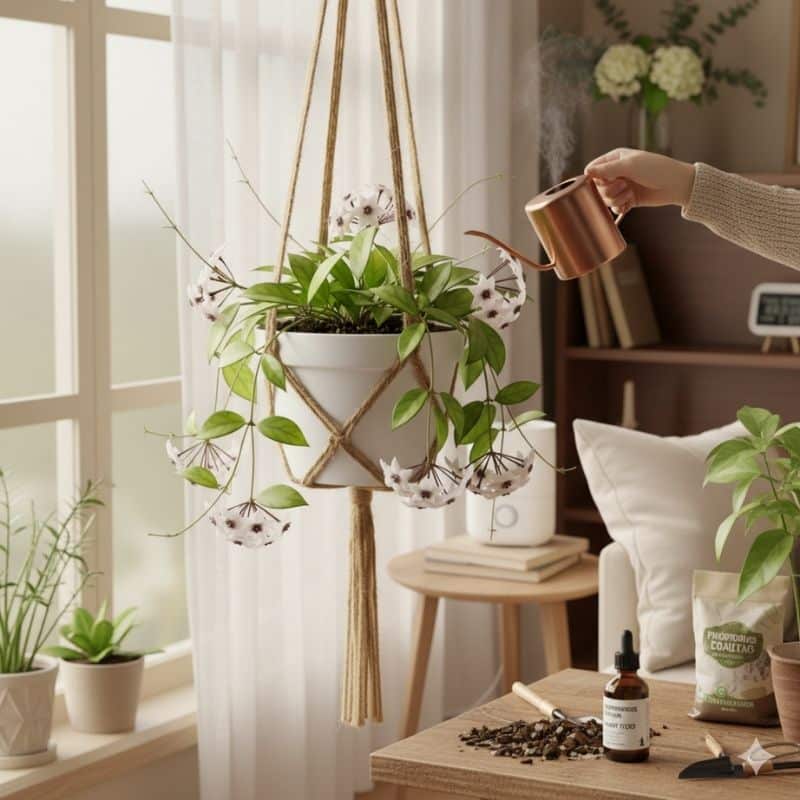
Light:
The Sweet Spot Hoya Bella flourishes in bright, indirect light. An east-facing window is ideal. It can burn in harsh, direct afternoon sun, and it will fail to bloom in low light. Finding that perfect, gentle brightness is key to encouraging flowers.
Watering:
The Most Important Rule This is where many Hoya lovers go wrong. Do not let your Hoya Bella dry out completely.
- Check the Soil Often: Water when the top inch of the soil feels dry, but the rest of the pot is still lightly moist.
- Aim for “Evenly Moist”: The goal is a soil that feels like a well-wrung-out sponge, not soggy and not bone dry.
- Reduce in Winter: In the cooler months, you can allow the soil to dry out a little more, but never for an extended period.
Soil:
Fast-Draining is Essential Because you’ll be keeping the soil more consistently moist, a very well-draining and airy soil mix is absolutely critical to prevent root rot. An orchid mix with added perlite and a bit of coco coir is perfect. A heavy, water-retentive soil will be a death sentence for this plant.
Humidity and Temperature:
A Warm, Humid Haven Hoya Bella loves high humidity (60%+) and warm temperatures (18-27°C / 65-80°F). It will suffer in dry air or cold drafts. It’s an excellent candidate for a brighter bathroom, a greenhouse cabinet, or a spot near a humidifier.
Fertilizing:
Feed the Blooms As a frequent bloomer, the Hoya Bella appreciates regular feeding during the growing season. Use a balanced fertilizer high in phosphorus (a “bloom booster”) diluted to half-strength every 2-3 weeks in spring and summer.
Troubleshooting Common Hoya Bella Problems
Its delicate nature means it can show signs of stress quickly.
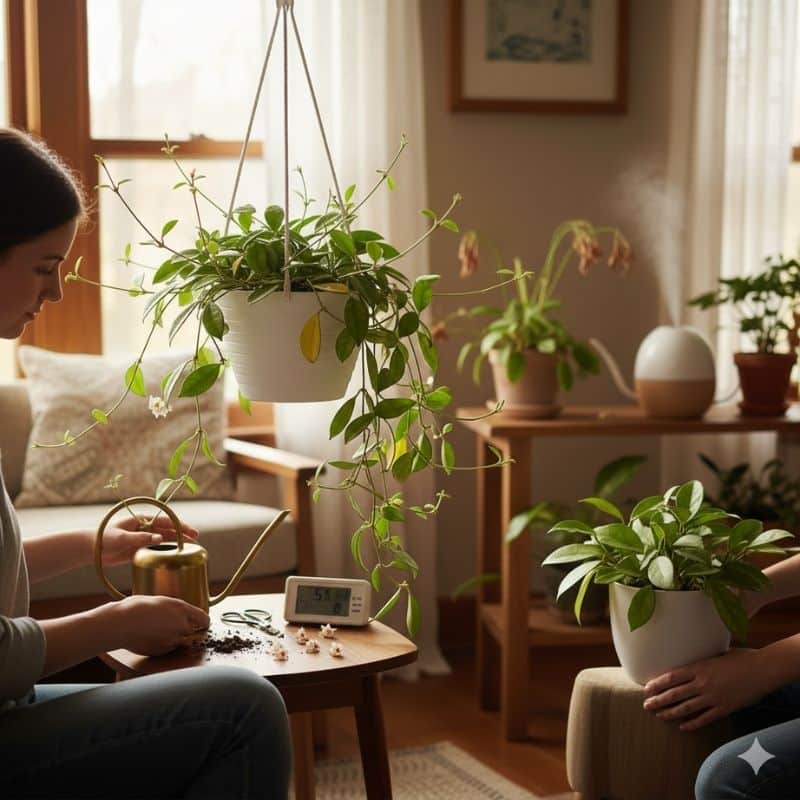
| Observed Problem | Possible Cause(s) | How to Fix It |
| Yellowing Leaves / Sudden Leaf Drop | This is the most common issue. Usually underwatering (soil got too dry) or overwatering (root rot from dense, soggy soil). | Feel the soil. If bone dry, water immediately. If soggy, check the roots for rot. Its fine roots are sensitive, so a consistent watering schedule is key. |
| Buds Forming Then Falling Off (Bud Blast) | Often caused by stress from a sudden change in conditions: the soil got too dry, a cold draft, or it was moved. | Once buds form, keep its environment as stable as possible. Maintain consistent watering. |
| No Flowers | Not enough light. This is the #1 reason for a lack of blooms. | Move the plant to a location with more bright, indirect light. An hour of gentle morning sun can also help. |
| Wrinkled, Lifeless Leaves | Severe underwatering. The plant has no water reserves. | Give it a thorough soak immediately. It may or may not recover, depending on how long it was dry. |
Frequently Asked Questions (FAQ) about Hoya Bella
Is Hoya Bella a good beginner plant?
It can be, but it’s often considered an intermediate-level Hoya. It is less forgiving about watering mistakes than Hoya carnosa. However, if you understand its need for consistent moisture, it can be very rewarding.
Why is my Hoya Bella dropping leaves?
Leaf drop is a classic sign of watering stress. Either the soil stayed dry for too long, causing the plant to sacrifice leaves, or the roots have rotted from being too wet, meaning they can no longer absorb water to support the leaves. Check your soil and adjust your routine.
Can I grow Hoya Bella in a regular pot?
You can, but it is best suited for a hanging basket. Its natural growth is to trail downwards. In a regular pot on a shelf, its beautiful cascading form will be fully appreciated.
Is Hoya Bella toxic to pets?
No. Like other Hoyas, Hoya bella is considered non-toxic to cats and dogs, making it a safe and beautiful choice for a pet-friendly household.
How can I encourage my Hoya Bella to bloom more?
More blooms come from more light. Move it to the brightest spot you have that doesn’t get direct, burning sun. Consistent watering and regular feeding with a bloom-booster fertilizer during the growing season will also trigger more flowers.
A Delicate but Dazzling Addition
The Hoya Bella may demand a little more attention than its tougher cousins, but its beauty is more than worth the effort. With its graceful, cascading vines and a constant supply of fragrant, star-like flowers, it’s a true showstopper.
By remembering its one golden rule—never let it dry out completely—you can successfully grow this miniature marvel and enjoy one of the most elegant members of the Hoya family.



